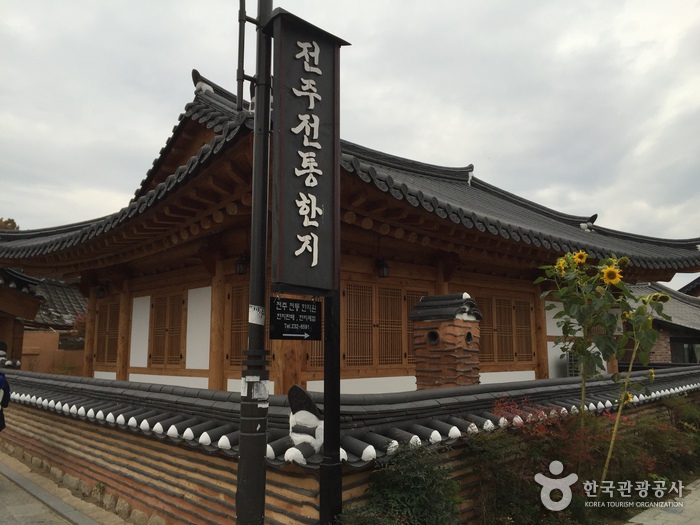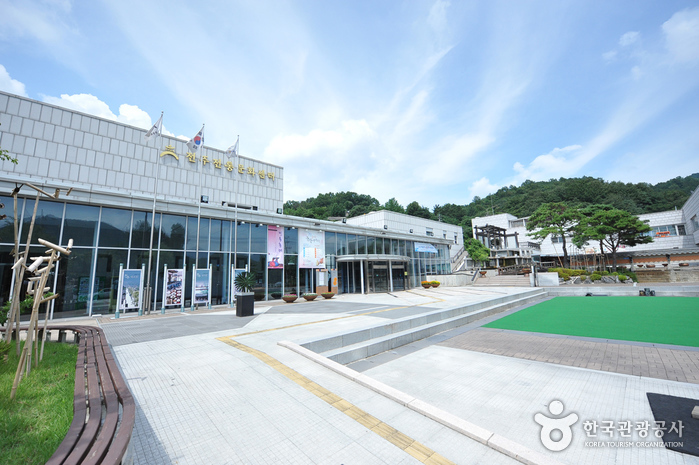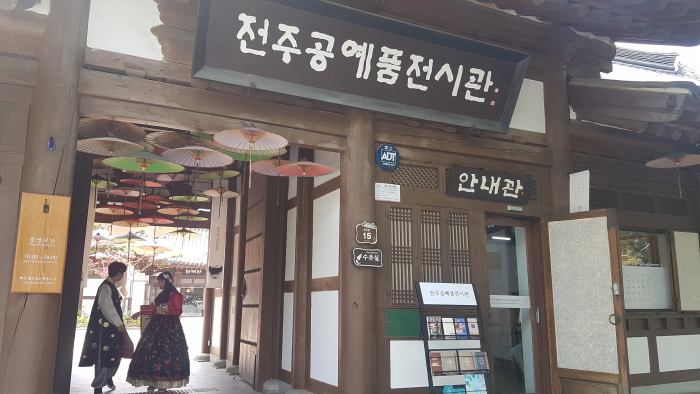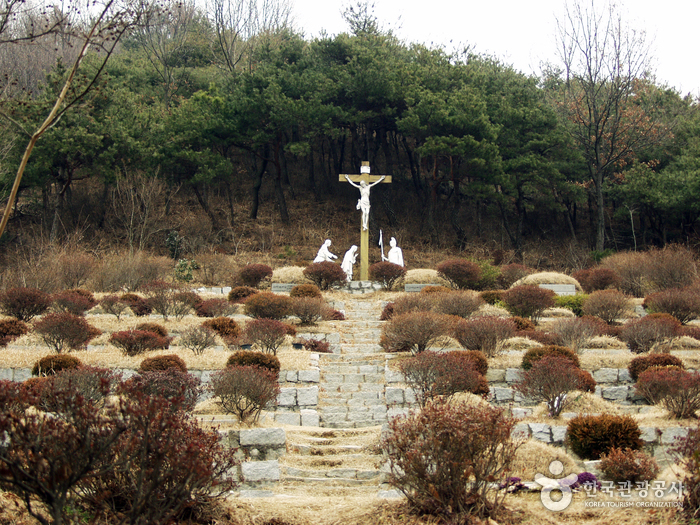Dong Nak Won [Korea Quality] / 동락원 [한국관광 품질인증]
2.3 Km 219 2024-04-07
33-6, Eunhaeng-ro, Wansan-gu, Jeonju-si, Jeonbuk-do
+82-63-287-9300
Hanok Hotel Dongrakwon used to be a memorial hall for Missionary M. Junkin who worked in Jeonju in 1985, and had long been used as an official residence for the Bank of Korea. The 100-year-old Hanok retains the history and culture that modern hotels do not have. Since the renovation to make it a hanok hotel, it is now utilized as a space for traditional music performances, traditional weddings, or small weddings. The entire building can be rented for various gatherings, seminars, conferences, family events, and so on. The beauty of a hanok is found in every corner of Dongrakwon such as the wide lawn, the pond in front of Sarangchae, and the jar stand next to Anchae. The antique furniture and folding screen in the rooms have been used for generations, enabling guests of the hanok to time travel to 50-100 years ago.
The yard is a great place to play simple Korean traditional plays such as Jegichagi and Dakjichiji, whereas the free-of-charge red clay sauna will relieve fatigue. The outdoor hot / cold bath and sun bath site is a new addition to Dongrakwon.
There is a 600-year-old Ginkgo tree standing on the Eunhang-ro, where the accommodation is located. Opposite the alley is Donghak Revolution Memorial Exhibition Hall; Gyeonggijeon East Gate is 200m away. The hotel is close to Taejo-ro, the busiest street of Jeonju Hanok Village; neighboring Eunhang-ro, Choi Myeong Hee-gil, and Eojin-gil all retain the unique quietness and beauty of Hanok Village. It will be also nice to ride on the mountain bike that Dongrakwon offers free of charge in order for guests to visit corners of the Hanok Village, or ride along the Jeonjucheon Stream.
Centro Tradicional del Hanji en Jeonju (전주전통한지원)
2.3 Km 14094 2024-04-07
Hanji-gil 100-10, Wansan-gu, Jeonju-si, Jeonbuk-do
Jeonju ha sido el mayor productor de papel tradicional hanji durante más de cien años. Aún mantiene esta orgullosa tradición y el Centro Tradicional del Hanji pretende preservar las técnicas tradicionales de fabricación de papel y ser el centro de la industria del hanji. Más del 80 por ciento del papel producido en el centro es exportado a Japón, y el resto se usa en Corea. El centro produce, expone y vende hanji para caligrafía, pinturas orientales y otros elementos artesanales.
Centro Cultural Hanbyuk de Jeonju (전주한벽문화관)
2.3 Km 3840 2023-04-06
Jeonjucheondong-ro 20, Wansan-gu, Jeonju-si, Jeonbuk-do.
El Centro Cultural Hanbyuk de Jeonju ofrece la oportunidad de conocer y experimentar las diferentes formas de cultura tradicional. Se puede disfrutar del pansori, minyo, danzas tradicionales y funciones durante todo el año. Además, podrá probar la comida representativa de Jeonju, el bibimbap (arroz con vegetales), y otros platos especiales en el pabellón de restaurantes tradicionales. También está provisto de una sala para ceremonias de bodas tradicionales.
Ilrakdang sarangchae [Korea Quality] / 일락당사랑채 [한국관광 품질인증]
2.3 Km 2872 2024-04-07
15, Choemyeonghui-gil, Wansan-gu, Jeonju-si, Jeonbuk-do
+82-10-3084-6679
A must visit place for tourists in Jeonju, Ilrakdang Sarangchae is located in the middle of the traditional Korean house village of Jeonju. The very first of three enjoyments for noble man, as indicated by Menicus, the existence of parents and brothers with no troubles is what the place is named after. Standing in the garden, you can easily see the stone walls of Gyeonggijeon and also you are within the range of walking distance to Jeondong catholic church, Omokdae, Southern market, Jeonju Hyanggyo, and the wall painting village of Jaman.
The rooms are called, Haengbokchae, Sarangbang, Mitum band, Monday, Tuesday, Wednesday, Thursday, Friday, Saturday, Sunday and so on. Haengbok room 1/2, a living room with furnace, a big sized attic above the living room are shared together, which makes it most suitable for big families or a small group of tourists. The Monday/Tuesday/Friday/Saturday/Sunday rooms all have a small, cozy attic and in every guest room’s wall, column and doors are mainly made of woods which makes them feel very warm. On every morning, in the shared kitchen, simple breakfasts mainly consisting of toasts, jams, coffee and juice are served. All guests are provided with discounts on Korean costume rental(30%), motor bikes(30%) and waengi bean sprout soup with rice (1000KRW). Besides, there are various services such as introduction to tasty restaurants in partnerships with traditional Korean house villages, as well as discounts, and try out of Korean rice cake making experiences and so on.
GaEunChae2 [Korea Quality] / 가은채2 [한국관광 품질인증]
2.3 Km 204 2024-04-07
100-20, Hanji-gil, Wansan-gu, Jeonju-si, Jeonbuk-do
+82-10-6335-5267
Gaeunchae 2 is the sister accommodations of Gaeunchae and is located behind the Jeonju Korean Traditional Wine Museum. Completed in 2011, the traditional Hanok has soil walls and soil Ondol floors finished with traditional Hanji wallpaper and Hanji floor paper for greater traditional beauty. The exposed rafter and gray wall design make for the unique interior atmosphere of Hanok. Sculptures such as stone lantern and stone tiger in the garden, old rectangular stone, and terrace stone in the yard make the Hanok even more elegant. The small floor in the room just in front of the door is a versatile space where one can put luggage or sit and have a chat.
Being situated close to the busy Taejoro in Jeonju Hanok Village, Gaeunchae 2 offers easy access to major tourist sites of the village including Jeondong Catholic Cathedral, Gyeonggijeon, Imokdae, etc. which are within walking distance. Guests can have a food trip as well as visit great restaurants and cafes clustered nearby.
Samrockhon [Korea Quality] / 삼락헌 [한국관광 품질인증]
2.4 Km 7345 2024-04-07
47-8, Eunhaeng-ro, Wansan-gu, Jeonju-si, Jeonbuk-do
+82-10-7799-7358
Samllakheon is located in the center of Jeonju Hanok Village which is the highlight of traveling in Jeonju. Samllakheon has been opened newly by the owner husband and wife who are running Bugyeongdang, a lodging in traditional Korean style house. The building of Samllakheon used to be the etiquette training center of Jeollabuk-do Province, and its size is much larger and more magnificent than ordinary houses and its style is very antique. The arrangement of the houses, the pillars, rafters, crossbeam and the ridge of the roof are clearly different from those of ordinary houses. The garden covered with pebbles and rocks and the well-tended flower bed are also worth seeing.
The rooms are composed of the five rooms of Spring, Summer, Fall, And, & Winter. Every room has a duplex attic under the high ceiling and a warm and clean restroom. The guests can help themselves with coffee, tea, toast, etc. for breakfast from the communal mini kitchen. The guests of Samllakheon can have 50% discount on Korean traditional clothes and 30% discount on rent of electric bike. It is also possible to experience traditional culture including making Injeolmi rice cake, Korean paper art, pottery and fragrant purse by making a reservation in advance.
The owners of the house can give information on Jeonju Hanok Village, many other tourist attractions and famous restaurants in Jeonju area. Major tourist attractions within walking distance are Jeondong Catholic Church, Gyeonggijeon, Gyodong Art Center, Choi Myung-Hee Literature Center, Omokdae, Jeonju Hyanggyo, Pungnammun Gate nd Nambu Market & Youth Mall.
Omokdae e Imokdae (오목대와 이목대)
2.4 Km 30826 2024-04-07
Girin-daero 55, Wansan-gu, Jeonju-si, Jeonbuk-do.
Omokdae está situado en la cima de una colina y se trata de uno de los lugares donde Yi Seong-gye (quien se convirtiera más tarde en el rey Taejo, el primero de la dinastía Joseon) hizo una parada para celebrar su victoria de camino a casa tras la guerra contra los invasores japoneses, al final de la era Goryeo. Enfrente de Omokdae está Imokdae, situado cerca de los pies del monte Seungamsan, donde se encuentra Chimyeongjasan, un monumento católico. En este lugar, Mokjo (antepasado del rey Taejo) solía jugar con sus amigos a representar guerras de niño, una acción muy simple que aparecería después en 'Yongbieocheonga', una balada del siglo XV que narra los logros culturales de la nación.
Sala de Exhibición de Artesanías de Jeonju (전주공예품전시관)
2.4 Km 5263 2024-04-07
Taejo-ro 15, Wansan-gu, Jeonju-si, Jeonbuk-do.
+82-63-282-8886
La sala fue inaugurada el día 20 de abril del 2002. Presenta una edificación tradicional y exhibe todo tipo de artesanías de la región de Jeollabuk-do. Está formada por las siguientes instalaciones anexas: el museo de exposición de artesanías, el centro de actividades, el espacio destinado a tomar té y adquirir los artículos fabricados por los famosos artesanos, y la tienda de suvenires. Entre las actividades disponibles hay artesanías en papel tradicional hanji, en cerámica, en madera, en bordados tradicionales, etc., entre otros materiales.
Escuela Confuciana Jeonju Hyanggyo (전주향교)
2.4 Km 4530 2024-05-07
Hyanggyo-gil 139, Wansan-gu, Jeonju-si, Jeonbuk-do.
Es una escuela confuciana que fue fundada en la dinastía de Joseon (1392-1910) y fue designada como Tesoro Histórico. Fue un establecimiento educativo del período de Joseon que estuvo originariamente ubicado en el sitio del santuario Gyeonggijeon, pero fue relocalizado en este lugar en 1603. Las tablillas mortuorias de 7 eruditos confucianos chinos y los 18 eruditos coreanos están conservadas en el edificio principal llamado Daeseongjeon.
Santuario Chimyeongjasan (치명자산성지)
2.4 Km 4684 2024-04-07
Baramssoeneun-gil 89, Wansan-gu, Jeonju-si, Jeonbuk-do.
Se encuentra localizado en la cima del monte Seungamsan, que es el escenario de fondo del pabellón histórico Hanbyeokdang, ubicado en el área sudeste de la ciudad de Jeonju. Hacia el costado de una gran cruz de piedra, con aproximadamente 4 metros de altura, se ha fundado una iglesia católica sobre una roca tallada. En este santuario descansan los restos de la pareja de Yu Jung-cheol (Juan) y Lee Sun-i (Rugalda), y el resto de los miembros familiares. Yu Hang-geom, el primer fiel católico de Corea, y padre de Yu Jung-cheol, nació en el pueblo Chonam, Iseo-myeon, de Wanju-gun. Después de sufrir opresiones y persecuciones por cuestiones religiosas, fueron decapitados en las afueras de Nammun. La pareja de Yu Jung-cheol y Lee Sun-i, luego de mantener la virginidad por sus ideales religiosos hasta después de 4 años de haberse casado, finalmente fueron condenados a muerte. La enorme cruz de piedra puede ser observada desde las distintas partes del área, y es famosa como lugar de peregrinación de los cristianos. Los túmulos de la pareja se encuentran enterrados en la parte más alta del santuario, y hacia un lado está presente la iglesia conmemorativa. Por encima de donde se encuentra la tumba de la pareja, se ve asomando la roca milagrosa (de Jesús y María), designado Patrimonio Natural por la excelencia de la escultura. Otra de las bellezas para apreciar es el camino que se presenta desde el comienzo hasta la cima de la montaña, que se asemeja a una alfombra de flores.
![Dong Nak Won [Korea Quality] / 동락원 [한국관광 품질인증]](http://tong.visitkorea.or.kr/cms/resource/16/2595016_image2_1.jpg)


![Ilrakdang sarangchae [Korea Quality] / 일락당사랑채 [한국관광 품질인증]](http://tong.visitkorea.or.kr/cms/resource/57/2596657_image2_1.jpg)
![Samrockhon [Korea Quality] / 삼락헌 [한국관광 품질인증]](http://tong.visitkorea.or.kr/cms/resource/02/2596602_image2_1.jpg)



 Español
Español
 한국어
한국어 English
English 日本語
日本語 中文(简体)
中文(简体) Deutsch
Deutsch Français
Français Русский
Русский